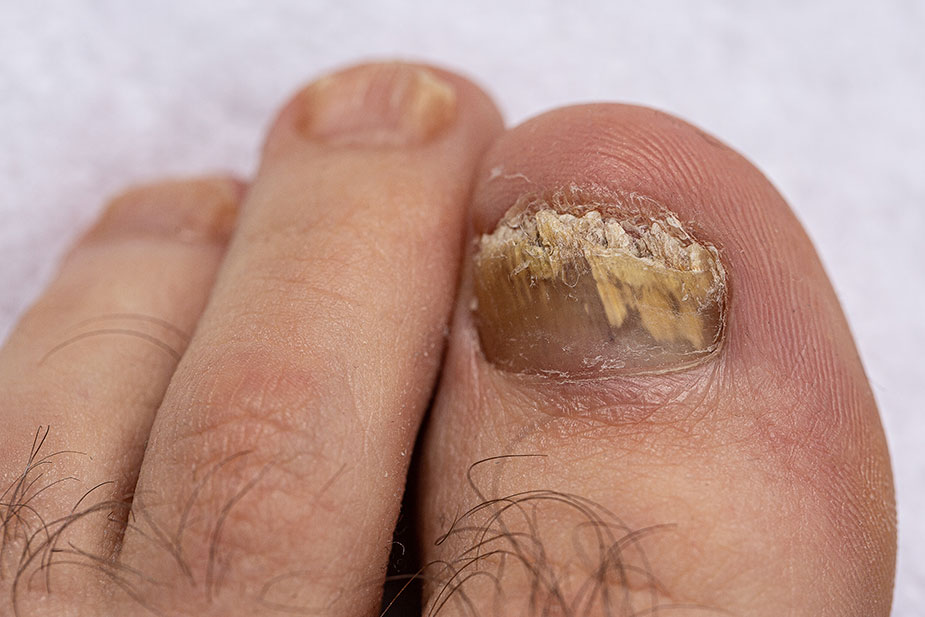Toenail fungus, also known as onychomycosis, is a common and often unpleasant infection that can affect the appearance, health, and function of your toenails. This problem occurs when microscopic fungi, most commonly dermatophytes, penetrate the nail and begin to multiply.
As the fungi grow and spread, they can cause symptoms such as thickening, brittleness, discoloration, and separation of the nail from the skin.
Prevalence of Onychomycosis
Toenail fungus is not a rare occurrence; it is estimated that up to 10% of the adult population suffers from onychomycosis. This issue is more common in older individuals but can also occur in younger people, particularly athletes and those with weakened immune systems.
The Importance of Timely Treatment
Timely treatment of toenail fungus is essential for several reasons. First, if left untreated, the fungus can cause permanent nail deformity and the spread of infection to other nails or parts of the body.
Second, untreated onychomycosis can lead to pain and discomfort when walking, which can impact a person’s quality of life.
Finally, timely treatment can reduce the risk of complications in individuals with weakened immune systems or diabetes.
Symptoms and Diagnosis of Toenail Fungus
Common Symptoms
Toenail fungus can cause various symptoms, with some of the most common including:
- Changes in nail color: The nail may turn yellow, brown, green, or white.
- Thickening of the nail: The nail may become thickened, making it harder to shape and cut.
- Nail brittleness: Nails become fragile, easily breaking and crumbling.
- Irregular nail shape: The nail may change its shape, becoming curved or distorted.
- Separation of the nail from the skin: The nail may begin to detach from the skin underneath, which can be painful.
How to Diagnose
If you notice any of these symptoms, it is essential to visit a doctor for a diagnosis and appropriate treatment. The doctor will examine your nails and discuss the symptoms you have noticed.
In some cases, the doctor may take a sample of the infected nail to send to a laboratory for analysis. Lab tests can confirm the presence of fungi and help the doctor determine the best treatment for your situation.
Causes of Toenail Fungus
Common Culprits
There are several types of microorganisms that can cause toenail fungus. The most common culprits are:
- Dermatophytes: These are fungi that feed on keratin, a protein found in nails, skin, and hair. The most well-known dermatophytes that cause onychomycosis are Trichophyton rubrum, Trichophyton interdigitale, and Epidermophyton floccosum.
- Yeasts: Candida is a type of yeast that can cause nail infections, especially in people with weakened immunity or those who frequently keep their hands in water.
- Molds: Although less common, molds such as Scopulariopsis and Aspergillus can also cause toenail fungus.
Risk Factors
There are several factors that can increase the risk of getting toenail fungus:
- Humid environment: Fungi thrive in warm, moist conditions, so frequent exposure to such environments (e.g., gyms, swimming pools, saunas) can increase the risk of infection.
- Injuries: Injuries to the nail or skin around the nail can allow fungi to penetrate and cause an infection.
- Weakened immunity: People with weakened immunity, such as those with HIV, diabetes, or cancer, have a higher risk of getting toenail fungus.
- Older age: As we age, nails become drier and more prone to cracking, which can lead to infection.
- Sharing towels, footwear, or nail tools: Using other people’s towels, footwear, or nail tools can increase the risk of infection, especially if those items are contaminated with fungi.
Treatments for Toenail Fungus
Topical Treatments
Topical treatments, such as creams, nail polishes, and gels, are applied directly to the infected nail to combat fungus. Some of the most commonly used topical medications include:
- Amorolfine: This antifungal nail polish is applied to the nail once or twice a week to prevent the spread of fungi.
- Ciclopirox: This antifungal cream or nail polish is used daily to reduce nail infection.
- Efinaconazole and tavaborole: These are newer topical treatments applied directly to the infected nail.
Oral Medications
Oral medications are taken by mouth and may be more effective than topical treatments, especially in more severe cases of toenail fungus. Some of the most commonly used oral medications include:
- Terbinafine: This antifungal medication is typically taken once a day for 6 to 12 weeks.
- Itraconazole: This medication can be taken once or twice daily, usually for 3 months.
- Fluconazole: This medication can be taken once a week but usually requires a longer treatment, from 6 to 12 months.
Oral medications can have side effects, such as nausea, diarrhea, or headaches, so it’s important to talk to a doctor before starting them.
Alternative Treatments
There are also some alternative treatments for toenail fungus, which include:
- Natural Remedies: Some people use natural remedies, such as tea tree oil, oregano oil, or baking soda, to combat toenail fungus. The effectiveness of these treatments can vary, and not all are scientifically proven.
- Laser Therapy: Laser treatments use a high-energy beam of light to target and destroy fungi in the nail. This treatment can be expensive, and its effectiveness varies from person to person. It’s essential to talk to a doctor before starting any treatment for toenail fungus to ensure you choose the best option for your situation.
Preventing Toenail Fungus
Hygiene and Foot Care
One of the key factors in preventing toenail fungus is maintaining good hygiene and foot care. Here are some tips to help you preserve the health of your nails:
- Wash your feet regularly: Clean your feet daily with mild soap and water, then thoroughly dry them, especially between the toes.
- Trim your nails regularly: Properly and regularly trim your nails to reduce the chance of injury and fungal entry into the nail.
- Shoes and socks: Wear breathable shoes and moisture-wicking socks to reduce humidity and create unfavorable conditions for fungal growth. Avoid sharing shoes with others.
- Public places: If you use public locker rooms, gyms, swimming pools, or saunas, wear flip-flops or sandals to reduce the risk of infection.
Carefully Use Nail Tools
To reduce the risk of spreading fungus, be mindful of the tools you use for nail care:
- Disinfect tools: Regularly disinfect nail tools, such as clippers, files, and cuticle sticks, with alcohol or another disinfectant.
- Avoid sharing tools: Refrain from sharing nail tools with family members or friends to reduce the risk of transmitting fungi.
- Be cautious with manicures and pedicures: If you go for a professional manicure or pedicure, make sure the salon uses sterile tools and adheres to hygienic protocols.
Strong Immunity Defeats Toenail Fungus
Boosting your immunity can help you resist toenail fungus infections:
- Balanced diet: Eat healthily and consume enough vitamins and minerals to strengthen your immunity.
- Physical activity: Regular physical activity improves circulation and strengthens immunity.
- Sufficient sleep: Ensure you get enough sleep, as it plays a crucial role in boosting the immune system.
By following these tips, you can reduce the risk of getting toenail fungus and preserve the health of your nails.
Early Detection and Treatment
Early detection of toenail fungus symptoms is important so that you can promptly begin the appropriate treatment:
- Regularly inspect your nails: Frequently examine your toenails, looking for changes in color, shape, or thickness.
- Pay attention to pain: If you feel pain around the nail or skin, it may be a sign of infection.
- Visit a doctor: If you notice any toenail fungus symptoms, see a doctor to get a diagnosis and proper treatment.
Prompt intervention can help prevent the spread of infection and maintain the health of your nails. Also, visit your doctor regularly for routine check-ups and foot health monitoring, especially if you have a chronic health issue or are in a higher risk group for developing toenail fungus.
Can Diet Prevent Toenail Fungus?
While diet alone cannot entirely prevent toenail fungus, it can play a significant role in strengthening the immune system and improving overall health, which may reduce the risk of infection.
Some dietary recommendations for toenail fungus prevention include:
- Balanced diet: Eat a diverse range of foods rich in vitamins, minerals, and nutrients. Focus on fruits, vegetables, whole grains, lean proteins, and healthy fats.
- Probiotics: Incorporate fermented foods, such as yogurt, kefir, sauerkraut, and kombucha, into your diet. Probiotics can enhance digestion and strengthen immunity.
- Fiber: Consume fiber-rich foods, like fruits, vegetables, and whole grains, to improve digestion and support gut health.
- Vitamin C: Eat foods rich in vitamin C, such as citrus fruits, strawberries, bell peppers, and broccoli, to enhance immunity and help fight infections.
- Zinc: Foods high in zinc, like meats, legumes, nuts, and seeds, can support a healthy immune system and assist in combating fungal infections.
- Omega-3 fatty acids: Consuming omega-3 fatty acid-rich foods, such as fish, nuts, and flax seeds, can reduce inflammation and improve immunity. Although diet can help strengthen the immune system, it alone cannot guarantee that you will avoid toenail fungus. Good foot hygiene, proper nail care, and regular doctor visits complement a healthy diet in preventing this issue.
Conclusion: Battling Toenail Fungus
Toenail fungus is a common and persistent problem that affects many people. Early symptom detection and timely treatment are key to successfully resolving this issue. Several treatments can be effective, including topical and oral medications, as well as alternative methods like natural remedies and laser therapy.
Prevention is the best way to combat toenail fungus. Maintaining good hygiene and foot care, using nail tools carefully, strengthening immunity, and early symptom detection are steps that can help you avoid this unpleasant infection.
If you suspect you have toenail fungus, be sure to consult a doctor for appropriate treatment and resolution of this issue. Remember, caring for your nails and feet is an essential part of maintaining your overall health and well-being.
. . .
“The greatest wealth is health.” – Virgil
. . .




